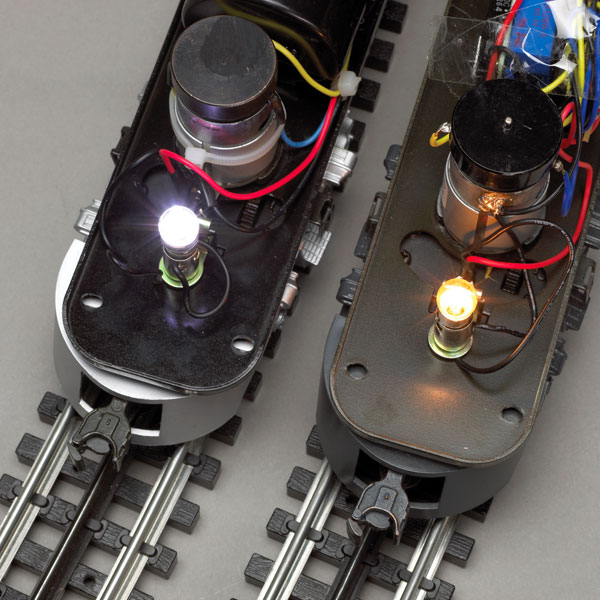LEDs are “light-emitting diodes.” As electricity flows through these specialized semiconductors, photons are released and focused through a lens, creating light. LEDs don’t have filaments that heat up and burn out like incandescent bulbs, so they last seemingly forever and require little electricity to operate.
Scott’s LED “bulbs” fit anywhere ordinary toy train bulbs would fit, yet they use a fraction of the power required by typical 14- or 18-volt incandescent bulbs and create virtually no heat. That means more power for trains and accessories, plus no concerns that overly hot bulbs will melt plastic. These LEDs also have a life expectancy measured in the tens of thousands of hours.
Scott’s offers its LED lamps in three lens styles, three colors, and with either standard-sized screw or bayonet (two-prong) bases that fit prewar, postwar, and some modern-era equipment.
The three lens styles are focused, inverted, and four-LED. The focused-lens LED shines straight ahead in a manner befitting a locomotive headlight. It measures 1 inch from top to bottom. The inverted LED has a flat top, and most of its light shines to the sides, making it ideal for Lionel track-switch lamps and many passenger cars. It is 7/8 inch long. The brightest of the three is the four-LED lamp, which as its name suggests, contains four LEDs in a single socket. The four-LED lamp is 11/16 inches long.
All of these items are available in clear (white light), red, or green. The red and green LEDs have clear lenses, so they look like clear lamps until they are illuminated. All are designed to operate at 12-14 volts AC.
We tried the LED lamps in a variety of trains and accessories. The clear LEDs produced an intense bluish-white light, very different from the customary yellow glow of an incandescent bulb. As advertised, the focused-lens LED produced a searing beam of light when viewed head-on, but merely glowed when viewed from the sides. The inverted-style LED produced plenty of side illumination, but not much from the top.
Most of the oohs and ahhs were reserved for the red and green LEDs. Without power, they look identical to the clear LEDs, except for a dot of red or green paint. But when powered up, each produced a red or green focused light just as intense as the clear LEDs.
All the LED lamps reached their peak light output at about 10 volts. We had no problems when the voltage was turned up to 18, beyond the 12-14 range recommended. LEDs do not grow continually brighter as voltage increases.
If, like me, you like the possibilities of adding LED illumination but are reluctant to build resistor circuits to operate them, there’s nothing to hold you back now.















I've purchased the WHITE color LEDs and they are NOT
WHITE. They have a bluish tint which I have used inside
structures to give the appearance of a TV on only.
This was a while ago so there may have been an improvement since then.